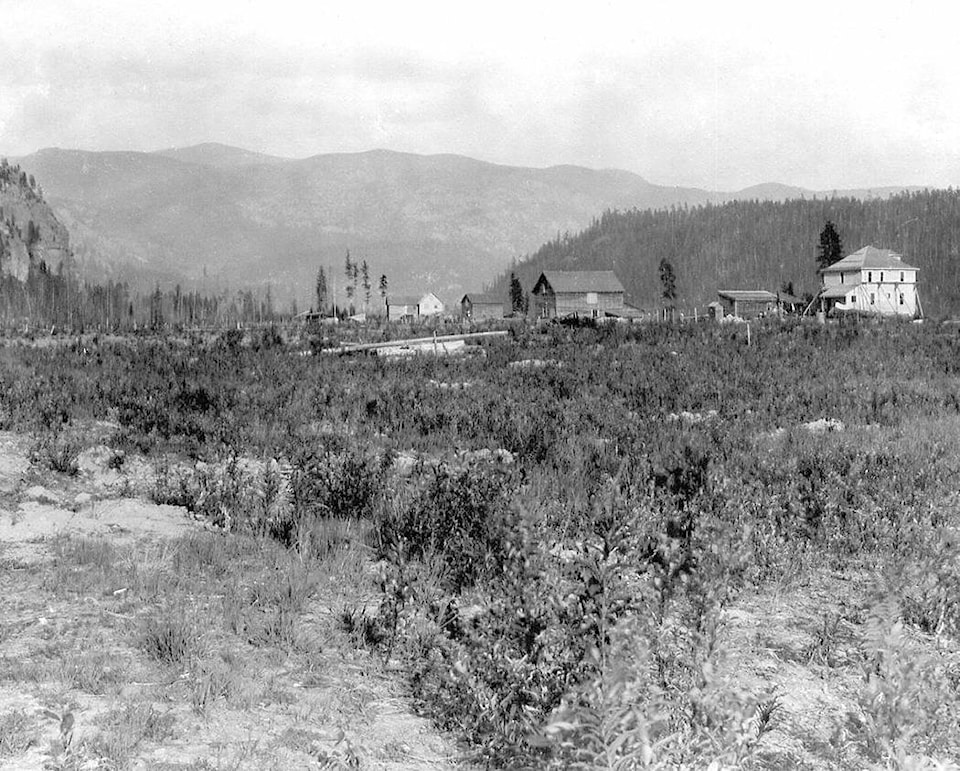Part two of a four-part series.
One peculiarity of the new 1907 subdivision plan for Robson is its omission of the original CPR townsite, which included a stationhouse and hotel.
With the influx of new landowners the hotel was once more a busy place. Robson townsite resurfaced in later plans, surrounded by the larger, longer lots. To look after the spiritual needs of the new settlers, McDermid & McHardy land agency offered a block of land along the eastern townsite border to the Baptist Home Mission Board of BC for the erection of a church. The 2.5 acre property neatly filled in the gap between the original and new surveys. The Board paid for the construction of the small church and the land agency provided a bell for the belfry. Robson residents contributed much-needed volunteer labour.
When Dr. A. P. McDiarmid arrived in 1912 he took on the responsibility of conducting regular church services without compensation, an obligation he faithfully kept until his health gave out in the mid-1940s. Although his mind was now occupied by the myriad of challenges presented by the new pioneering life, he did not neglect his ties to Brandon College.
His true greatness appears in the fact that when he retired from the leadership of Brandon College he watched her struggles and her progress with deep interest and concern, yet without a breath of criticism or a shadow of interference. It was his great joy that when the college proved too great a burden for his beloved denomination, the means were found to keep the college in being and perpetuate the work, the foundations of which he had so well and truly laid so many years before.
The orchard and gardens continued to be expanded and more outbuildings were constructed. These included a large barn and a 12 x 50 foot chicken house that could accommodate nearly a thousand birds. Charles Squires found a new use for his N.J. Halpin & Company prescription pads, which now recorded prescriptions for soil amendments, information on seed stocks, and planting records. Much of the new work now was in block 33, where a planting grid was laid out around the buildings that had been erected during the previous years. Nine planting rows running away from the river towards the mountainside were laid out 28 feet apart and numbered, and trees were planted along them every 14 feet.
Orchard stock was obtained from various suppliers, including British Columbia Nurseries (Vancouver), Fraser Valley Nurseries, as well as Riverside Nurseries in Grand Forks. Orders were acquired by travelling salesmen and shipped out in time for either a spring or a fall planting. Prices for best-grade apple trees ranged between 40 cents (single) and 23 cents (in lots of a hundred). McDiarmid & Squires adopted the evocative name of Riverview for their operation. The year 1922 saw another wave of planting as more land was cleared towards the hillside, with a further 275 trees added, mostly apples.
By 1923 good returns could be reported on their orchard investment. In the apple division there were 770 producing trees yielding 1,635 boxes of fruit. Northern Spy, an excellent keeper, was the dominant tree, followed by Wagner, Delicious, Wealthy, and Stayman’s Winesap. Only a token sample of my own favourite apple, Cox’s Orange Pippin, was tried out, most likely on the advice of agricultural experts that suggested the variety should be grown only for export to the UK, presumably as demand for its unique taste had not been built up in the domestic market.
Eighteen pear trees produced 10 boxes of fruit. Among the stone fruits, the following trees produced the returns indicated in brackets: 14 peach (6); 11 apricot (22); 38 plum (44); and 49 cherry (60).
McDiarmid & Squires joined other local growers to form the Robson Cooperative Exchange, which provided communal packing and shipping facilities, and also offered raw materials and supplies to its members at cost.
The fruit was sold on the local market, as well as shipped to the prairies and elsewhere. The key to that was the excellent transportation system that existed at the time, which was supported by the north-south steamer runs and the east-west railway lines. McDiarmid & Squires were early starters in what would become a highly competitive industry, especially right after the Great War, when various incentives were offered to returning soldiers to join what formerly were largely “remittance men”, seeking a Utopian existence in the Canadian wilderness. In view of these developments, the Riverview operation started to diversify by adding floral horticulture to their commercial enterprise. In the process, they turned their Robson grounds into a garden paradise.
To be continued …
